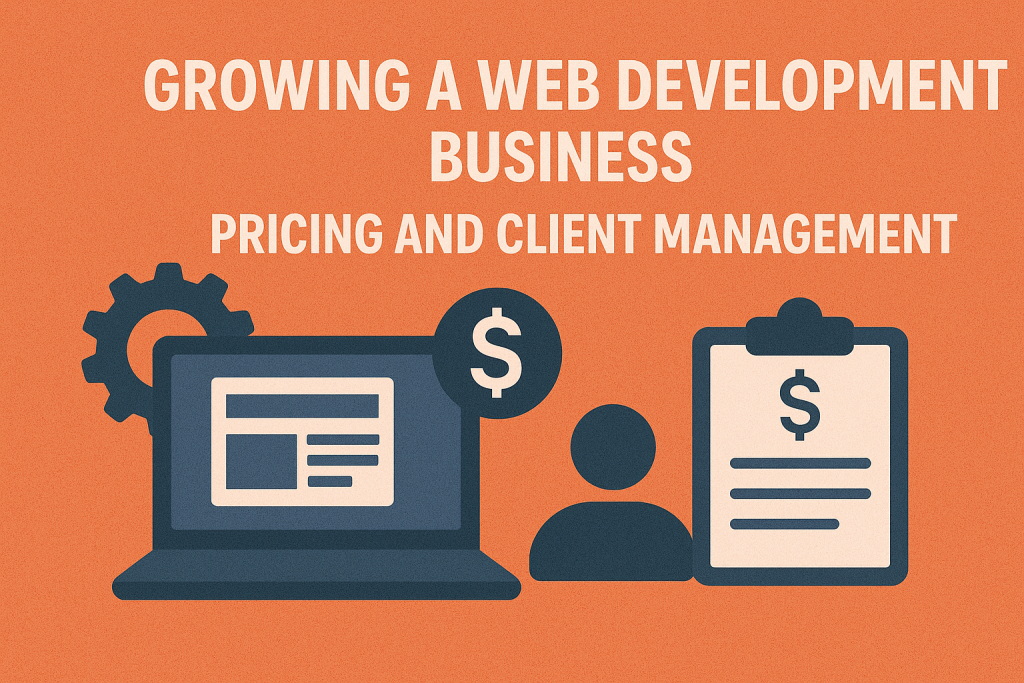Introduction
Thank you for reading this post, don't forget to subscribe!Starting and growing a web development business can be an exciting yet challenging endeavor. Whether you’re a freelancer or running a small agency, understanding pricing strategies, effective client management, and business growth tactics is essential for long-term success. This article explores key strategies to scale your web development business, set competitive prices, and manage clients effectively.
Building a Strong Foundation
Before diving into pricing and client management, it is crucial to build a strong foundation for your web development business. Here are some steps to consider:
1. Define Your Niche
Rather than offering all web development services, focus on a niche that aligns with your skills and market demand. Specializing in areas like eCommerce development, WordPress customization, or SaaS application development can help you stand out.
2. Create a Portfolio
Clients need proof of your skills. Develop a portfolio showcasing your best work, case studies, and testimonials from satisfied clients. If you’re just starting, consider working on a few projects at a discounted rate to build credibility.
3. Set Up a Professional Online Presence
A professional website and an active presence on LinkedIn, GitHub, and freelance platforms can help attract clients. Your website should display your portfolio, list your services, and include clear contact information.
Pricing Strategies for Web Development
Pricing your services correctly is critical to sustaining and growing your business. Setting the wrong price can either undervalue your work or drive potential clients away. Below are different pricing approaches you can implement:
1. Hourly Pricing
- Best for projects with evolving requirements.
- Suitable for new freelancers who are unsure about project scope.
- Some clients may be hesitant if they feel the estimated hours are too high.
2. Fixed Pricing
- Works well for projects with a clearly defined scope.
- Helps clients know costs upfront, reducing financial surprises.
- If the project requires more time than estimated, it may impact profitability.
3. Value-Based Pricing
- Charges are determined by the impact your work has on the client’s business.
- Ideal for businesses looking to improve revenue through their website.
- Requires thorough market research and an understanding of the client’s objectives.
4. Retainer-Based Pricing
- Provides ongoing support, maintenance, and updates for a set monthly fee.
- Ensures a steady income stream and long-term client relationships.
- Suitable for clients who require continuous improvements and technical support.
Pricing Tips:
- Research competitors’ rates and position yourself accordingly.
- Consider hidden costs such as hosting, revisions, and client communication.
- Ensure that additional changes and scope extensions are accounted for in pricing.
Effective Client Management
Building long-term client relationships is key to a successful web development business. Below are some strategies to maintain client satisfaction and secure repeat business:
1. Set Clear Expectations
Before starting a project, outline all terms, deadlines, and deliverables. A well-documented contract should cover payment terms, revision policies, and additional costs.
2. Communicate Regularly
Keep clients informed about project milestones and any potential delays. Open communication fosters trust and helps prevent misunderstandings.
3. Use Project Management Tools
Utilize tools like Trello, Asana, or ClickUp to track tasks, deadlines, and client feedback. This improves efficiency and keeps both parties aligned.
4. Handle Challenging Clients Professionally
Occasionally, you may encounter difficult clients. Instead of reacting emotionally, stay professional, revisit project agreements, and offer clear solutions to resolve disputes.
5. Offer Post-Launch Support
Providing maintenance services after a project is completed helps build long-term relationships and generates recurring revenue.
Scaling Your Web Development Business
Once you have a steady stream of clients, consider scaling your business for greater profitability.
1. Automate Repetitive Tasks
Utilizing automation tools for invoicing, scheduling, and client onboarding can save time and enhance workflow efficiency.
2. Delegate Work
As your workload increases, consider outsourcing tasks or hiring a team to manage project execution while you focus on business expansion.
3. Expand Your Service Offerings
Integrate complementary services like SEO, content writing, or digital marketing to attract more clients and provide complete solutions.
4. Leverage Client Referrals
Satisfied clients are one of the best sources of new business. Encourage them to refer your services by offering discounts or incentives.
5. Invest in Marketing
Enhancing your online presence through social media, SEO, and email marketing can increase brand visibility and attract high-quality leads.
Conclusion
Growing a successful web development business requires a blend of strategic pricing, effective client management, and scalable business practices. By setting the right foundation, pricing your services competitively, and fostering strong client relationships, you can build a thriving business that stands the test of time. Implement these strategies, stay adaptable, and watch your web development business flourish.

